Invention, proliferation and development of gunpowder and instruments of its use, that is, firearms changed the world. The old ways of hunting, self-protection and armed conflict underwent radical shifts. Moreover, better firearms won wars and that changed rulers or governments. Thus gunpowder, though often forgotten, certainly exerts an indirect influence on our history.
The black gunpowder, which is a carefully calculated mixture of saltpeter, sulphur and charcoal, is a Chinese invention, an earliest form of which is believed to have been assembled in the mid-ninth century. Of these three components, sulphur and charcoal act as fuels, while saltpeter supplies necessary oxygen to burn the fuel at a very fast rate. The earliest written formula for explosive powder containing these three was found in a Song dynasty military handbook, the Wujing Zongyao, written between 1040 and 1044 AD. Since then, over the ages, the proportion, quality, manufacturing technique of the ingredients of gunpowder and their mixing process underwent countless upgrades as science and technology moved forward.
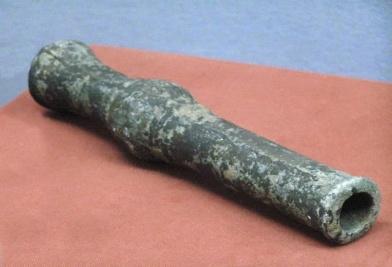
Mongols encountered gunpowder weapons in wars against their Chinese enemies and learned the use of gunpowder from the captured Chinese technicians. This technology was carried west to Muslim Asia by the invading Mongol armies. Between 1260 and 1368 the contact between China and the Islamic world was at its peak, when Mongols ruled significant parts of both of these regions. Among many transfers of science and technology that it facilitated was that of gunpowder from Chinese to Arab and Muslim world. The European monks, mainly Franciscans and Dominicans, men of education and enquiry carried the gospel to Mongol court and often brought back knowledge of ancient Greek and Chinese origin, including that of gunpowder. The first European manuscript of the 13th century on gunpowder ‘Liber Ignium’ attributed to Marcus Graecus (Mark the Greek), contains information that is taken from the works of a contemporary Arab writer whose essays in turn reflect Chinese text. Ottoman Turks, who were perpetually fighting Christian Europe quickly learned the use of gunpowder and became the leader of the Muslim firearms users. Europe adopted firearms more efficiently than the Muslim world.
The Mongol Empire of Timur declined after his death in 1405, resulting in more use of sea routes for commercial activities. The Indian ports of Calicut, Cochin, Quilon, Cambay, Surat, Goa, Mumbai, Cannanore had active trade links with Europe, the Ottoman and Arab world, China and South-East Asia. It was but natural that the knowledge of gunpowder weapons reached Indian shores through these trade routes.
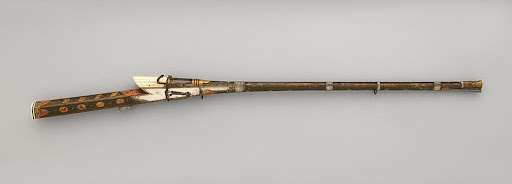
Generally it can be stated that gunpowder and firearms reached North-West India by land from Middle East and Iran, to South India it came by sea from China and Europe, to Bengal from South China by sea and to Assam from China by land-route.
The belief that gunpowder came to India through Babur in the first battle of Panipat (1526) has now changed. Modern researchers have found that gunpowder technology reached certain parts of India before Babur. The earliest textual reference to pyrotechnics based on gunpowder in Delhi Sultanate is by Amir Khasru, who wrote that during the reign of Jalaluddin firuz Khalji (1290-96) ‘Hawai’ (fire rocket) existed in Delhi. A century later we come across the writings of Shams Siraj Afif who wrote that during the time of Sultan Firoz Shah Tughlaq (1351-88) ‘flower scattering rockets’ were launched during the Muslim festival of ‘Shab-barat’. By the middle of the 14th century ‘Tir-i-hawai’ or fire rockets appeared in certain kingdoms of Deccan as a weapon of war.
Cannons reached some parts of India during the second half of the 15th century. These were brass or bronze cast pieces firing stone made cannonballs. Cannons were used by different rulers of India to smash the walls and fortifications of the forts at Mewar (1442-43), Mandalgarh (1456-57), Belgaon (1472-73) and Champaner (1484-85). Before the advent of Mughals, cannons arrived from different sources to Kashmir, Malwa, some parts of Deccan, Bengal and Assam. Contemporary writing has recorded that four European deserters manufactured many light cannons for the local Indian ruler at Calicut, Kerala, in the year 1506. Large cannons were used against the enemy forts to breach their walls, while smaller cannons were used by the defenders from the ramparts of the forts. There is no record of use of cannons in India in open battlefields against infantry and cavalry before Panipat (1526).
The credit of the first use of firearms in India in open battlefield goes to Babur (Panipat,1526). With him he brought the following instruments of war that use gunpowder.
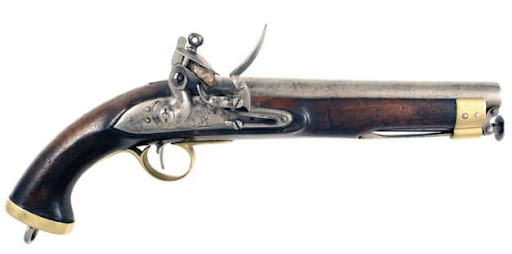
Kazan – Heavy cannon with wooden carriage having four wheels, pulled by 4-5 elephants. These cannons used to fire large cannon balls to breach the walls of the enemy forts.
Zarb Jan – Light cannon with wooden carriage having two wheels, pulled by 4 oxen. They are artillery pieces used in flat open battlefields and can easily be moved from one place to another as per the need of the battle.
Firingi – Light cannon. Its description is not available.
Tufang – A muzzle loader gun, fired by ignition of gunpowder by touching a burning wick to a small hole at the base of the gun barrel. A soldier who fired Tufang was called ‘Tufangchi’.
Mughal power established itself in totality in Bengal at the time of Emperor Jahangir in the year 1612. But by that time firearms had already reached Bengal. Sultan Hussain Shah of Bengal used cannons in battle in 1513-14 CE. The ‘baro bhuiyan’s of Bengal used firearms against Mughals till they surrendered or were defeated. To quote from a reference – ‘Isa Khan and his allies sometimes plundered Mughal supplies for firearms, or employed Portuguese mercenaries, who hired out their services to Mughal and anti-Mughal forces alike. In 1583 some three thousand artillerymen, apparently renegade Portuguese, were in the employ of anti-Mughal forces in East Bengal’.
The belief that gunpowder came to India through Babur in the first battle of Panipat (1526) has now changed. Modern researchers have found that gunpowder technology reached certain parts of India before Babur. The earliest textual reference to pyrotechnics based on gunpowder in Delhi Sultanate is by Amir Khasru, who wrote that during the reign of Jalaluddin firuz Khalji (1290-96) ‘Hawai’ (fire rocket) existed in Delhi.
The early muzzle loader gun that employed the first ‘trigger’ to move a curved metal hook with a burning wick fixed at its tip is called a ‘matchlock gun’. Pressing the trigger brings the burning wick with a snap to a cup shaped gunpowder filled ‘flash-pan’. The burning wick ignites the gunpowder in the flash-pan, which in turn ignites the gunpowder in the barrel through a ‘touch-hole’, shooting a round lead ball out of the gun barrel. Matchlock guns came into use in the middle of the 15th century and reached Bengal through Chinese traders and Portuguese mercenaries. From 1650 CE onwards more advanced ‘Flintlock’ guns came into use that used sparks, generated by friction of a piece of flint, to ignite the gunpowder in the barrel.
There are a number of terracotta panels found in some Temples of Bengal that depict hunting scenes or soldiers marching carrying Matchlock / Flintlock guns.
There is a light cannon on display at the National Museum of Bangladesh. It is made of cast brass or Bronze. An inscription on it reveals that it was manufactured in the year 1538, during the tenure of the last independent Sultan of Bengal Ghiyasuddin Mahmud Shah.
Beside the above mentioned cannon of Sultan Mahmud Shah, there are at present, three other important old cannons available for our study in West Bengal. Each one represents a particular manufacturing technique of the time. Let us take a look at them.
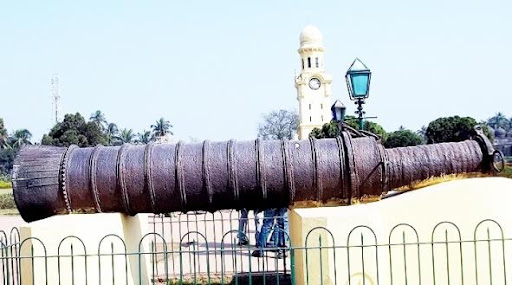
Bacchawali Tope
In front of Hazar Duari palace in Murshidabad on two masonry pedestals stands the massive Bachawali Top. This cannon is believed to be made in the 15th century. It is an example of ‘stave and hoop’ manufacturing process that originated in Europe. The diameter of the bore is 48.26 cm. The inner surface of the barrel is made of long staves of iron placed side by side in a circular pattern bound by eleven ‘heat-shrink-fitted’ wrought iron rings. Bachawali was found on a sand bank at Gour, Malda and brought at the present sight of Murshidabad on a later date. The cannon has two parts. The larger part is the barrel which is 3.5 Meter long. The muzzle end rim has petal-like ornamentation. There are rings to facilitate lifting of the heavy barrel. The smaller part, which is 1.09 Meter long, is the powder chamber that had to be loaded with gunpowder and fixed securely to the end of the barrel for firing. To fire the cannon it had to be mounted on a large wooden carriage with wheels. This type of cannon was used to fire stone balls to smash the walls of enemy forts. Bachawali Top is the only cannon found in eastern India having such a unique two-part design.
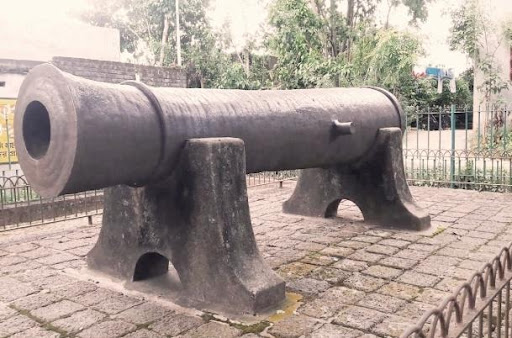
Dal madal or Dal mardan
This cannon is at Bishnupur. The correct name is “Dal Mardan ” meaning ‘Crusher of group of people’. No accurate record of manufacture of this cannon is available but it is believed to be made around 1550 AD. This is one of the notable early forge welded canons found in India. Dal Mardan is made of groups of three iron rings put over each other. A total of sixty three similar three-ring assemblies were used to produce the thickness of the main barrel of the cannon. It is 3.84 meters long and weighs approximately 7.9 tons. The iron that was used to manufacture this cannon has extra Phosphorus, that is why it is not affected by atmospheric corrosion. The metallurgical and engineering knowledge as well as the black smithy skills of the ancient experts, who forged this wonderful piece of wrought iron cannon, must be highly appreciated. Apart from the strict dimensional tolerances that were required in the fabrication of the individual rings (with their varying diameter, thickness and width depending upon their location along the gun barrel), it would have required tremendous skill in the design and execution as the whole operation had to be conducted in a very high temperature, when iron was still soft. Manufacture of this cannon was a costly project of the then ruler of Bishnupur, an inscription on the cannon shows that it cost a little over one lakh rupees in those days.
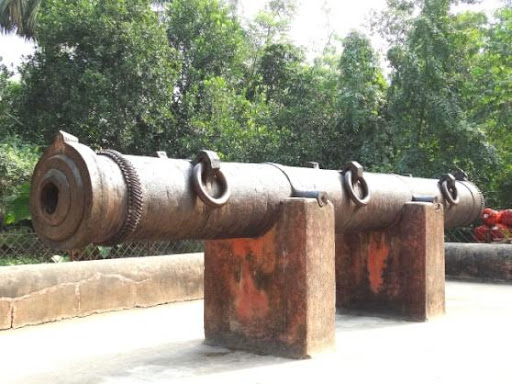
Jahan Kosha
The name means ‘Destroyer of the world’. This great gun stands on a raised platform in the erstwhile ‘Top Khana’(Artillery Yard) of the Nawab of Murshidabad. It was manufactured by a more advanced forging process. The manufacturing technique, design and ornamentation of this cannon clearly shows an improvement in technology and aesthetics over that of ‘Bachhawali’ and ‘Dal madal’ cannons. It is interesting to mention that before it was displayed at the present site, this massive cannon was embedded in a Peepal tree, which lifted this huge cannon en masse four feet above the ground. A photograph of this phenomenon is available in the Hazarduari Museum, Murshidabad. The cannon is 5.33 Meter long. Diameter of the barrel is 15.2 Cm. For each firing of this gun 26 kg. of gunpowder was required. Jahan Kosha was manufactured at Dacca in 1637 AD by Janardan Karmakar, during the reign of Shah Jehan, under the supervision of Hara Ballav Das. It fired iron cannonballs. On the gun there are nine brass plates with inscriptions. At present the inscriptions have been obliterated by constant touch of hands of the tourists.
There are some other important cannons and guns kept in various places and collections in West Bengal that help us to understand the history of gunpowder in this part of the country.
This essay is an extremely brief narration of the story of the arrival and development of gunpowder and cannon making technology in Bengal up to the 17th century. Further developments were led by the Europeans that came to India through the French, the Dutch East India Company and the English East India Company, all of whom partly depended on gunpowder to protect their respective interests and to expand the area under their control. Indian rulers tried to assimilate the western technologies and tactics. Development of gunpowder and gunpowder using devices continued to achieve victory in armed conflicts and India`s history moved on.
All images (unless otherwise mentioned) are from the author’s collection.
Heritage conservation activist and firearm enthusiast. Specialises in identification, technical narration and history of period firearms. Writes and lectures on period cannons and guns. Extended his voluntary service to KMDA, various Museums, Police forces and Ordnance factories.






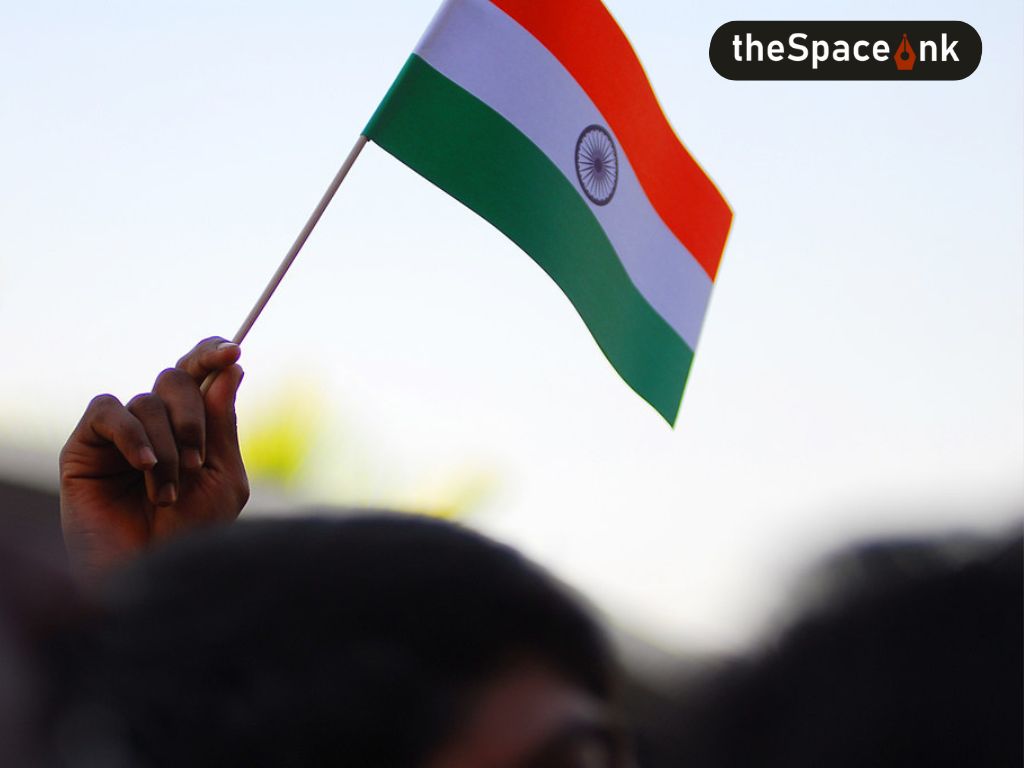
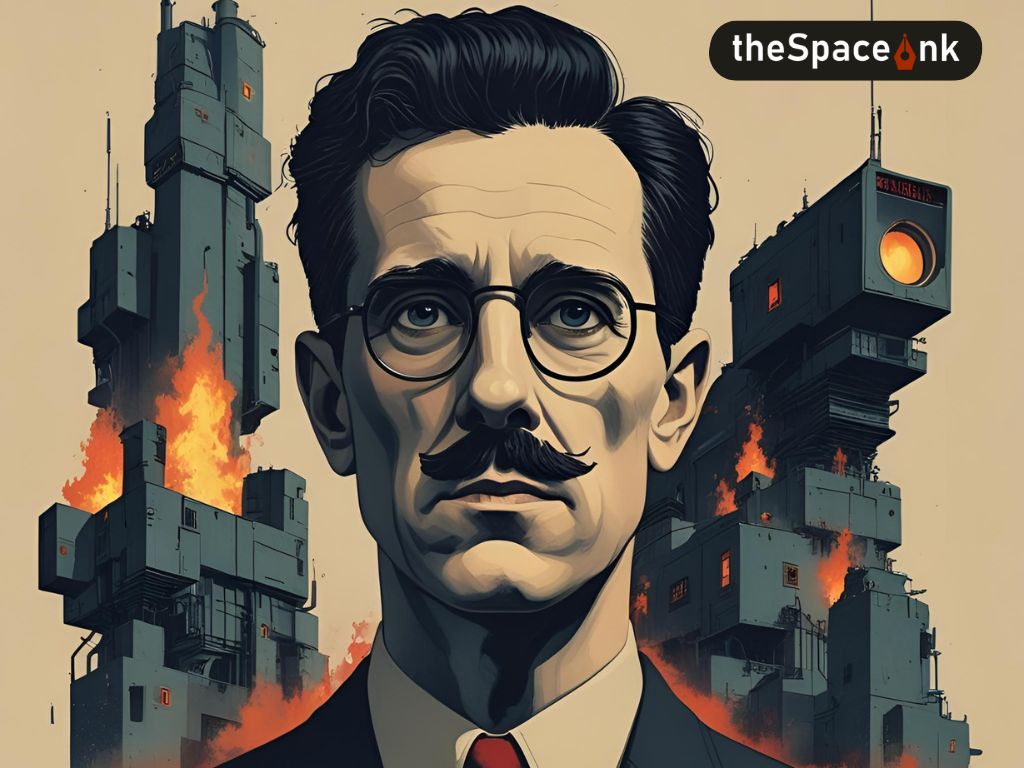
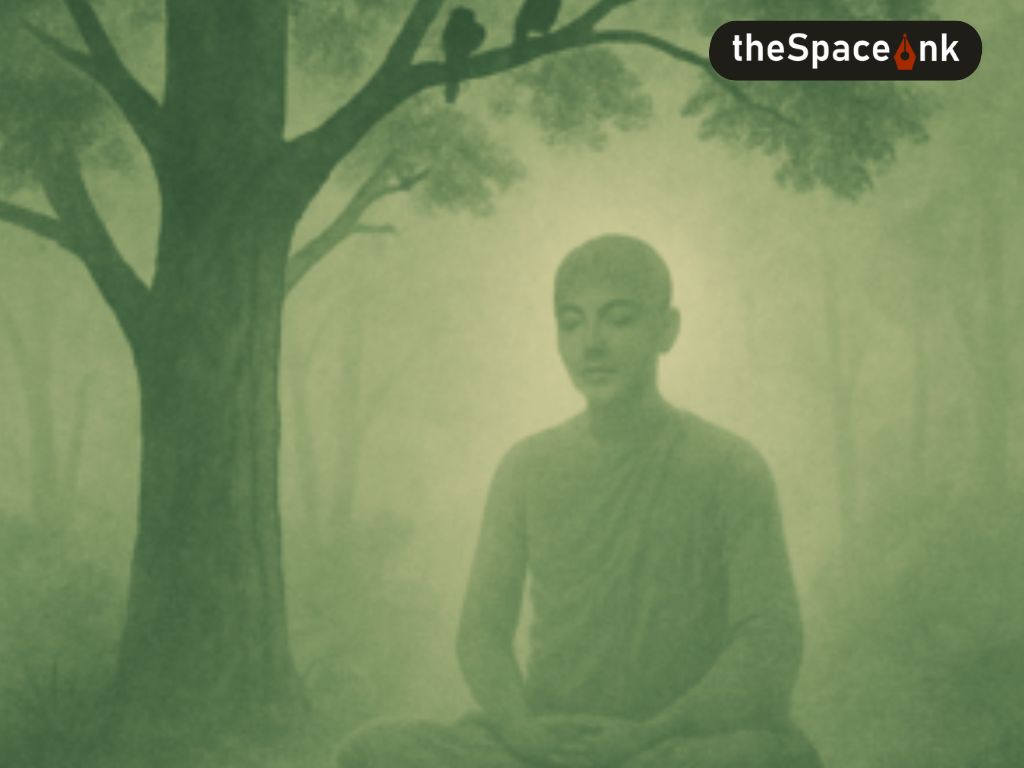
One Response
An excellent piece of writing. Well researched and contextualised.